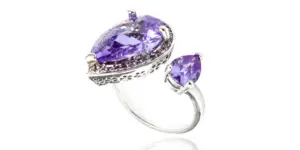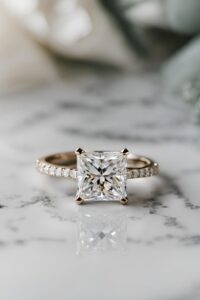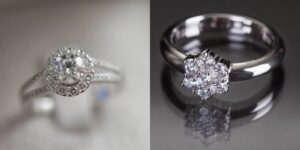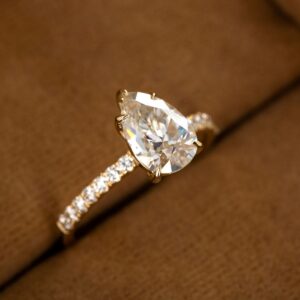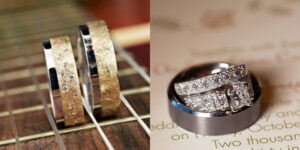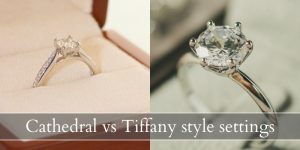Wondering what kind of setting to use for your engagement ring ? Your design choices can really personalize a ring that might otherwise be very similar to what your friends or family members wear. So if you’re looking for a discrete twist on the classic solitaire setting, then the double prong is a great idea. Let’s debate the pros and cons of double and single prong settings to help you explore this option.
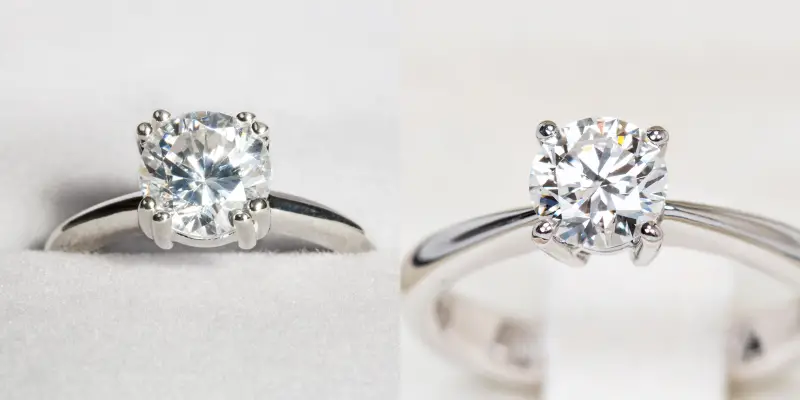
Double prong vs single prong setting
Double prong settings are a more modern look, and they work best with larger stones (+1 ct) where the prongs won’t hide as much of the stone. If done correctly double prongs can be very beautiful, but few jewelers have the skill and finesse necessary to produce actual double prongs, instead of a single prong with a cut down the middle. It’s much easier to find a very well made single prong setting than a double prong one, if you’re shopping for a ready-made ring.
In short, single prong settings are more common, easier to find, and you stand a much higher chance of finding a perfectly executed one. Double prongs are more of a novelty item, hard to find very well made. But if you do find well made double prongs, they can offer more protection than the standard single prong, as you have a backup if one of the prongs were to ever break.
Double prong settings look more modern
Looking for something a bit more modern, something different from the usual solitaire look ? Then perhaps the double prong is a good option. A double prong setting is a nice twist on the usual 4-prong setting, and can add a bit more character. It’s simpler than a halo, but adds just enough to make the ring different.
However if you want to go more traditional, or for a look that is very familiar, then a single prong setting is better.
Read also: Diamond Cut VS Color
Single prong settings are simpler, more sleek
Since single prongs are a single metal post, they tend to look more sleek, more minimalist than a double prong. This means they won’t distract form the diamond or gemstone, and your ring will not look like it has too much going on.
Sometimes a double prong can be distracting, and sometimes they’re so well done they add more than the substract from the diamond. Still, it’s a general rule of thumb that double prongs won’t look as elegant as single prongs, simply because there is more on the diamond.
Double prong settings may offer more security
Because there is more on the diamond, it also means there’s an extra set of prongs holding onto that gem, so added security. This means that while in a normal 4 prong ring one prong breaking off will lead to losing the diamond, in a double prong (if done well!!) each prong has a sort of backup. If one prong breaks there is another one, a millimeter away, also holding onto the diamond.
Single prong settings offer less security when compared to double, but only when you compare 4-prong single. If you were to get 6 or 8 prongs, all equidistant, you’d get better security than even a double prong setting!
So really it’s down to exactly what kind of single prong setting you’re comparing to the double prong. Also, please keep in mind that double prongs are often poorly made, so they may offer extra protection but this is not a guarantee.
Single prong settings are more common
Looking for pre-made rings ? Single prongs are far, far easier to come by. 4, 6, and even 8 prongs are very easy to find, especially if you’re just looking for a plain solitaire, a classic ring. A double prong that is ready-made is really not that easy to find, since the demand for these rings isn’t as high as single prong.
So keep that in mind. are you and/or your fiancee comfortable with working with a jeweler ? Then a double prong won’t be hard to find, it’ll just be a question of quality craftsmanship. Are you leaning more towards ready-made ? The a single prong is far easier to find.
Double prongs look better on larger stones
Double prongs are, essentially, an extra set of prongs, This means they will take up double the space on a diamond or gem, and they will block out double the light. Of course, the amount of light blocked may be visible only when looking very closely and comparing with a single prong, since it won’t be easily detectable with the unaided human eye. But the difference is there.
A good way to go around this is to use the double prongs on a larger stone, like a 1.5ct and up. The thickness of the prongs is the same, regardless of the stone size. But a larger stone won’t be affected as much by the double prongs, in terms of light.
In terms of exactly what kind of diamond cut works best with a double prong, anything with a clipped corner will go well. So a cushion, radiant, emerald cut (our personal fave!) all look great. Rounds and ovals also work very well with double prongs.
Always ask the jeweler for examples if going for a double prong
If you’re opting for a double prong you need to ask your jeweler for examples of other double prongs they’ve made. This is because it’s very difficult to make double prongs that look good, are actually two prongs, and are also efficient is not an easy feat. Examples of lazy or fake double prongs include:
- just single prongs that have a cut into the tip
- two very thin wires that don’t give enough support
- two thin prongs that are welded together, instead of having a bit of space between them
Ask your jeweler to provide photos of their work, and you’ll see how they generally do a double prong. It’s important that the prongs are separated from the base, so if one ever breaks or bends, the other one is separate and can still keep the gem in place. This is not easy to do.
If you’re buying a pre-made double prong ring, again make sure that the prongs are separate, are straight, and they both hold onto the gem tightly. Do not settle for anything less. A poorly made double prong can look bad, and can block more light from entering the diamond.

I’m the main author for jewelrymaterialguide.com. I started this site after we did tons of research before our wedding and noticed that there is information about rings, jewelry, and so on that is really hard to find on the internet.

